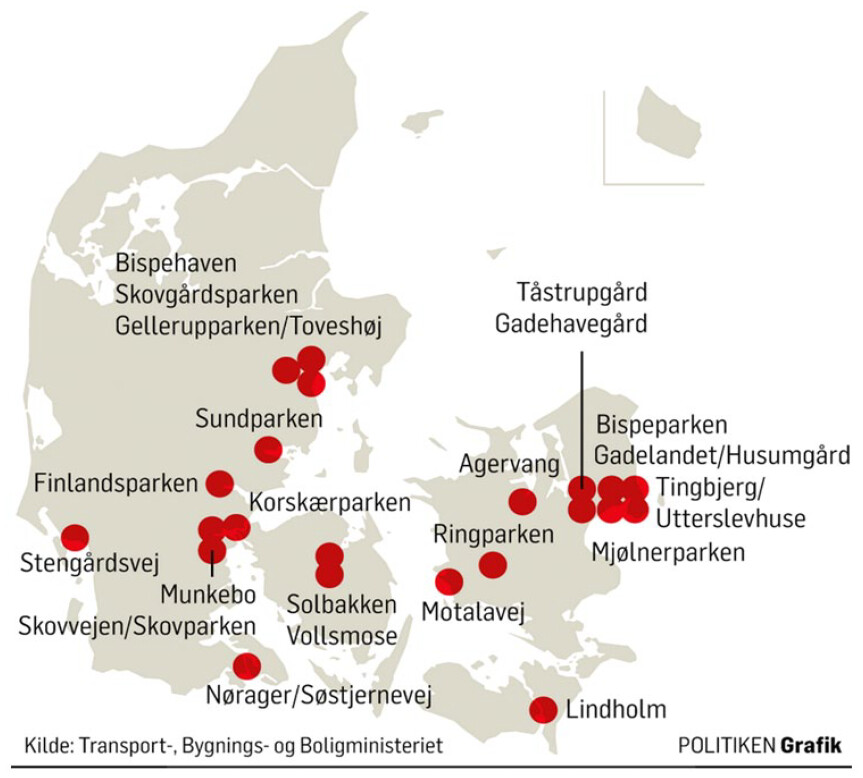By Maia Chakin
Denmark is known as a progressive socialist nation with a robust welfare system, yet this small, homogenous country does not serve all of its citizens equally. In the name of encouraging participation in Danish culture and reducing crime, the government has instituted a plan to eliminate the areas that it deems ghettos or “parallel societies” by 2030. This plan was originally put in place by right wing powers in 2018, yet, the center-left coalition currently in power has continued these policies while referring to the communities they are destroying as “parallel communities,” rather than ghettos.

Map of development plans for Denmark housing. Source: Politiken Grafik
The criteria for a neighborhood to be characterized as a ghetto/parallel society bluntly reveal the anti-immigrant sentiments behind this law. These neighborhoods must have at least half of the population is from non-western origin or descent (including both those who were not born in Denmark, and those who were born of immigrant parents) and at least two of the following characteristics: low income, low education rates, high unemployment rates or conviction rates of three times the national average. In areas that meet the above criteria, social housing levels need to be reduced to a maximum of 40 percent by 2030. A further statement by the Danish government in 2021 claimed that the goal of the parallel society policy was to reduce the percentage of people with non-Western backgrounds in a given residential area to 30 percent by 2030. Other elements of the government’s parallel societies initiative includes a policy requiring young children in areas deemed vulnerable to attend Danish preschool for at least 25 hours per week in order to learn the Danish language and values.
Danish officials justify this policy by claiming a lack of integration and participation in Danish society from these immigrant populations. The government’s One Denmark without Parallel Societies report claimed that there were “holes” in Denmark’s map where citizens were not taking “sufficient responsibility” because they did not “actively participate in the Danish language, society, and labor market” or “embrace Danish norms and values.” The government seems to believe that these non-westerners are taking advantage of Denmark’s social welfare system without giving back to the country. This assimilationist rhetoric discounts the importance of Non-western cultures and villainizes some of Denmark’s most marginalized populations.

A section of housing in Mjølnerparken. Photograph: Andrew Kelly/Reuters
The parallel societies plan is forcing largely non-western and non-white populations in Denmark out of their homes, which will be demolished and resold to wealthier (mostly non-immigrant) people. Although some people are fine with, or even happy about, being relocated to different neighborhoods, many residents are devastated to be forced out of places they have built their lives in. Mjølnerparken, a residential area in Copenhagen with one of the highest percentages of non-western residents, has faced extreme measures by the government, with some entire blocks of residents being forced-out.
Some officials claim that these policies are being put in place in order to provide people living in these low-income enclaves with better opportunities, but how is forcing people out of their homes the best way to achieve this? A quote in the New York Times by a woman from a social housing organization in Denmark makes the desires of those who live in these parallel societies clear: “If they made the program voluntary, most people would like to stay. The experiment would have failed.”
Works Cited
Bubola, Emma. “Denmark Aims a Wrecking Ball at ‘non-Western’ Neighborhoods.” The New York Times, October 26, 2023. https://www.nytimes.com/2023/10/26/world/europe/denmark-housing.html?smid =nytcore-ios-share&referringSource=articleShare.
“How Denmark’s ‘ghetto List’ Is Ripping Apart Migrant Communities.” The Guardian, March 11, 2020. https://www.theguardian.com/world/2020/mar/11/how-denmarks-ghetto-list-is-ripping-apart-migrant-communities.
John, Tara, and Susanne Gargiulo. “Denmark Is a Liberal Paradise for Many People, but the Reality Is Very Different for Immigrants.” CNN, July 20, 2020. https://cnn.com/2020/07/20/europe/denmark-ghetto-relocation-intl/index.html.
Wenande, Christian. “Forget Parallel Societies: Is the Ghetto Plan Stuck in a Parallel Universe?” The Copenhagen Post, October 17, 2022. https://cphpost.dk/2022-10-22/news/forget-parallel-societies-is-the-ghetto-plan-stuck-in-a-parallel-universe/.

What a disturbing yet fascinating blog post! I am stunned by the explicit racism of this policy, blatantly attacking “non-western” neighborhoods based on descent. This policy reminds me of the urban renewal in the U.S. Just as Americans viewed/view Black and minority neighborhoods as blighted “slums” requiring demolition, these Danish officials have adopted a similar outlook on non-Western residents.
I also find the Danish justification for this policy interesting, that it facilitates integration into Danish society. From what I have read, it seems many European nations harbor deep animosity toward the prospect of a multicultural future. While America also grapples with this problem, this fear may be especially prominent in Europe as European nations define themselves as the homes of specific cultural/ethnic groups: Denmark for the Danes, France for the French, etc. Over time, I hope resentment towards immigrants simmers, and European societies becomes mores inclusive.
Thank you for shedding light on such a heartbreaking event. I find it interesting how Denmark is often touted as almost this liberal utopia by many progressives in the United States, yet it suffers from the same racist and anti-immigrant sentiments that many Western nations are struggling with. In this way, I fear it will have the same fallout as the urban renewal policies in the United States. It is a shame to see the Danish government making the same mistake, knowing its very real and detrimental implications. Your blog post also reminds me much of MT Fullilove’s research on root shock. I believe the Danish immigrants will go through a similar trauma response when their surroundings are forcefully ripped away from them.
Additionally, as your post says, the government even outlined the fundamental issues, like low education and income. I found it extra frustrating that instead of addressing the genuine source of the high crime in these minority neighborhoods, such as fixing the school system or encouraging better employment, they have resorted to destroying the communities.